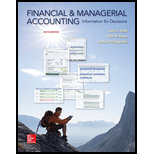
Concept explainers
Journalization:
It means record of financial data related to business transactions in a journal in a manner so that debit equals credit. It provides an audit trail to the auditor and a means to analyze the effects of transactions to an organization‘s financial health.
Rules of
- Assets: Increase in asset should be debit and decrease should be credit.
- Liabilities: Increase in liabilities should be credit and decrease should be debit.
- Equity: Increase in Equity should be credit and decrease should be debit.
- Expense: Increase in expense should be debit and decrease should be credit.
- Revenue: Increase in revenue should be credit and decrease should be debit.
Write off method for accounts receivable: This is a method of accounting for writing off
To prepare: Journal entry to record the unexpected payment from an uncollectible account receivable for which the record has been made with direct write off method.
Want to see the full answer?
Check out a sample textbook solution
Chapter 7 Solutions
Financial and Managerial Accounting: Information for Decisions
- What is the ending inventory?arrow_forwardExercise 10-8 (Algo) Prepare the stockholders' equity section (LO10-7) The Golden Mushroom has two classes of stock authorized 8%, $10 par preferred, and $1 par value common. The following transactions affect stockholders' equity during 2024, its first year of operations January 2 February 6 Issues 100,000 shares of common stock for $28 per share. Issues 2,300 shares of a preferred stock for $12 per share. September 10 Purchases 10,000 shares of its own common stock for $33 per share. December 15 Resells 5,000 shares of treasury stock at $38 per share. In its first year of operations. The Golden Mushroom has net income of $153,000 and pays dividends at the end of the year of $95,000 ($1 per share) on all common shares outstanding and $1,840 on all preferred shares outstanding Required: Prepare the stockholders' equity section of the balance sheet for The Golden Mushroom as of December 31, 2024. (Amounts to be deducted should be indicated by a minus sign) THE GOLDEN MUSHROOM Balance…arrow_forwardI need help with this general accounting problem using proper accounting guidelines.arrow_forward

 AccountingAccountingISBN:9781337272094Author:WARREN, Carl S., Reeve, James M., Duchac, Jonathan E.Publisher:Cengage Learning,
AccountingAccountingISBN:9781337272094Author:WARREN, Carl S., Reeve, James M., Duchac, Jonathan E.Publisher:Cengage Learning, Accounting Information SystemsAccountingISBN:9781337619202Author:Hall, James A.Publisher:Cengage Learning,
Accounting Information SystemsAccountingISBN:9781337619202Author:Hall, James A.Publisher:Cengage Learning, Horngren's Cost Accounting: A Managerial Emphasis...AccountingISBN:9780134475585Author:Srikant M. Datar, Madhav V. RajanPublisher:PEARSON
Horngren's Cost Accounting: A Managerial Emphasis...AccountingISBN:9780134475585Author:Srikant M. Datar, Madhav V. RajanPublisher:PEARSON Intermediate AccountingAccountingISBN:9781259722660Author:J. David Spiceland, Mark W. Nelson, Wayne M ThomasPublisher:McGraw-Hill Education
Intermediate AccountingAccountingISBN:9781259722660Author:J. David Spiceland, Mark W. Nelson, Wayne M ThomasPublisher:McGraw-Hill Education Financial and Managerial AccountingAccountingISBN:9781259726705Author:John J Wild, Ken W. Shaw, Barbara Chiappetta Fundamental Accounting PrinciplesPublisher:McGraw-Hill Education
Financial and Managerial AccountingAccountingISBN:9781259726705Author:John J Wild, Ken W. Shaw, Barbara Chiappetta Fundamental Accounting PrinciplesPublisher:McGraw-Hill Education





